Bobcat
Bobcats are elusive and nocturnal, so they are rarely spotted by humans. Although they are seldom seen, they roam throughout much of North America and adapt well to such diverse habitats as forests, swamps, deserts, and even suburban areas.
Bobcats, sometimes called wildcats, are roughly twice as big as the average housecat. They have long legs, large paws, and tufted ears similar to those of their larger relative, the Canada lynx. Most bobcats are brown or brownish red with a white underbelly and short, black-tipped tail. The cat is named for its tail, which appears to be cut or “bobbed.”
Fierce hunters, bobcats can kill prey much bigger than themselves, but usually eat rabbits, birds, mice, squirrels, and other smaller game. The bobcat hunts by stealth, but delivers a deathblow with a leaping pounce that can cover 10 feet.
Population
Bobcats are solitary animals. Females choose a secluded den to raise a litter of one to six young kittens, which will remain with their mother for 9 to 12 months. During this time they will learn to hunt before setting out on their own.
In some areas, bobcats are still trapped for their soft, spotted fur. North American populations are believed to be quite large, with perhaps as many as one million cats in the United States alone.
Eastern gray squirrel
The eastern gray squirrel (Sciurus carolinensis), also known, particularly outside of North America, as simply the grey squirrel, is a tree squirrel in the genus Sciurus. It is native to eastern North America, where it is the most prodigious and ecologically essential natural forest regenerator. [4] [5] Widely introduced to certain places around the world, the eastern gray squirrel in Europe, in particular, is regarded as an invasive species.
In Europe, Sciurus carolinensis is included since 2016 in the list of Invasive Alien Species of Union concern (the Union list). [6] This implies that this species cannot be imported, bred, transported, commercialized, or intentionally released into the environment in the whole of the European Union. [7]
Contents
Sciurus carolinensis is native to the eastern and midwestern United States, and to the southerly portions of the central provinces of Canada. The native range of the eastern gray squirrel overlaps with that of the fox squirrel (Sciurus niger), with which it is sometimes confused, although the core of the fox squirrel’s range is slightly more to the west. The eastern gray squirrel is found from New Brunswick, through southwestern Quebec and throughout southern Ontario plus in southern Manitoba, south to East Texas and Florida. [2] Breeding eastern gray squirrels are found in Nova Scotia, but whether this population was introduced or came from natural range expansion is not known. [8]
A prolific and adaptable species, the eastern gray squirrel has also been introduced to, and thrives in, several regions of the western United States and in 1966, this squirrel was introduced into Vancouver Island in Western Canada in the area of Metchosin, and has spread widely from there. They are considered highly invasive and a threat to both the local ecosystem and the native squirrel, the American red squirrel. [9]
Overseas, Eastern gray squirrels in Europe are a concern because they have displaced some of the native squirrels there. They have been introduced into Ireland, [10] Britain, Italy, South Africa, and Australia (where it was extirpated by 1973). [2]
In Ireland, the native squirrel – also colored red – the Eurasian red squirrel S. vulgaris – has been displaced in several eastern counties, though it still remains common in the south and west of the country. [11] The gray squirrel is also an invasive species in Britain; it has spread across the country and has largely displaced the red squirrel. That such a displacement might happen in Italy is of concern, as gray squirrels might spread to other parts of mainland Europe. [12]
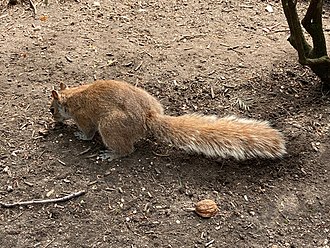
Etymology
The generic name, Sciurus, is derived from two Greek words, skia, meaning shadow, and oura, meaning tail. This name alludes to the squirrel sitting in the shadow of its tail. [13] The specific epithet, carolinensis, refers to the Carolinas, where the species was first recorded and where the animal is still extremely common. In the United Kingdom and Canada, it is simply referred to as the “grey squirrel”. In the US, “eastern” is used to differentiate the species from the western gray squirrel (Sciurus griseus).
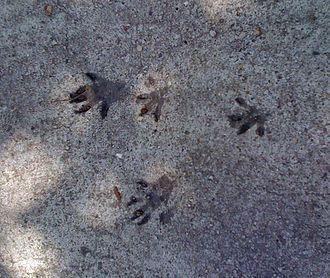
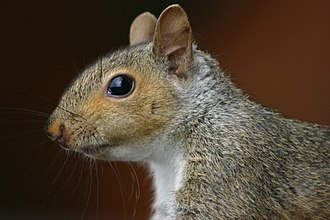
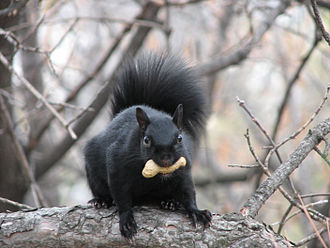
The eastern gray squirrel has predominantly gray fur, but it can have a brownish color. It has a usual white underside as compared to the typical brownish-orange underside of the fox squirrel. [14] It has a large bushy tail. Particularly in urban situations where the risk of predation is reduced, both white [15] – and black-colored individuals are quite often found. The melanistic form, which is almost entirely black, is predominant in certain populations and in certain geographic areas, such as in large parts of southeastern Canada. Melanistic squirrels appear to exhibit a higher cold tolerance than the common gray morph; when exposed to −10 °C, black squirrels showed an 18% reduction in heat loss, a 20% reduction in basal metabolic rate, and an 11% increase to non-shivering thermogenesis capacity when compared to the common gray morph. [16] The black coloration is caused by an incomplete dominant mutation of MC1R, where E + /E + is a wild type squirrel, E + /E B is brown-black, and E B /E B is black. [17]
The head and body length is from 23 to 30 cm (9.1 to 11.8 in), the tail from 19 to 25 cm (7.5 to 9.8 in), and the adult weight varies between 400 and 600 g (14 and 21 oz). [18] [19] They do not display sexual dimorphism, meaning there is no gender difference in size or coloration. [20]
The tracks of an eastern gray squirrel are difficult to distinguish from the related fox squirrel and Abert’s squirrel, though the latter’s range is almost entirely different from the gray’s. Like all squirrels, the eastern gray shows four toes on the front feet and five on the hind feet. The hind foot-pad is often not visible in the track. When bounding or moving at speed, the front foot tracks will be behind the hind foot tracks. The bounding stride can be two to three feet long. [21]
The dental formula of the eastern gray squirrel is 1023/1013 (upper teeth/lower teeth). [16]
1.0.2.3 1.0.1.3 × 2 = 22 total teeth.
Incisors exhibit indeterminate growth, meaning they grow consistently throughout life, and their cheek teeth exhibit brachydont (low-crowned teeth) and bunodont (having tubercles on crowns) structures. [16]
Behavior
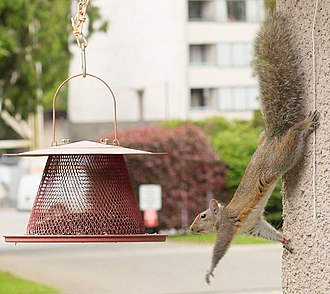
Reaching out for food on a garden bird feeder, this squirrel can rotate its hind feet, allowing it to descend a tree head-first.
Like many members of the family Sciuridae, the eastern gray squirrel is a scatter-hoarder; it hoards food in numerous small caches for later recovery. [2] Some caches are quite temporary, especially those made near the site of a sudden abundance of food which can be retrieved within hours or days for reburial in a more secure site. Others are more permanent and are not retrieved until months later. Each squirrel is estimated to make several thousand caches each season. The squirrels have very accurate spatial memory for the locations of these caches, and use distant and nearby landmarks to retrieve them. Smell is used partly to uncover food caches, and also to find food in other squirrels’ caches. Scent can be unreliable when the ground is too dry or covered in snow. [22]
Squirrels sometimes use deceptive behavior to prevent other animals from retrieving cached food. They will pretend to bury the object if they feel that they are being watched. They do this by preparing the spot as usual, for instance, digging a hole or widening a crack, miming the placement of the food, while actually concealing it in their mouths, and then covering up the “cache” as if they had deposited the object. They also hide behind vegetation while burying food or hide it high up in trees (if their rival is not arboreal). Such a complex repertoire suggests that the behaviors are not innate, and imply theory of mind thinking. [23] [24]
The eastern gray squirrel is one of very few mammalian species that can descend a tree head-first. It does this by turning its feet so the claws of its hind paws are backward-pointing and can grip the tree bark. [25] [26]
Eastern gray squirrels build a type of nest, known as a drey, in the forks of trees, consisting mainly of dry leaves and twigs. The dreys are roughly spherical, about 30 to 60 cm in diameter and are usually insulated with moss, thistledown, dried grass, and feathers to reduce heat loss. [20] Males and females may share the same nest for short times during the breeding season, and during cold winter spells. Squirrels may share a drey to stay warm. They may also nest in the attic or exterior walls of a house, where they may be regarded as pests, as well as fire hazards due to their habit of gnawing on electrical cables. In addition, squirrels may inhabit a permanent tree den hollowed out in the trunk or a large branch of a tree. [27]
Eastern gray squirrels are crepuscular, [19] or more active during the early and late hours of the day, and tend to avoid the heat in the middle of a summer day. [27] They do not hibernate. [28]
Reproduction
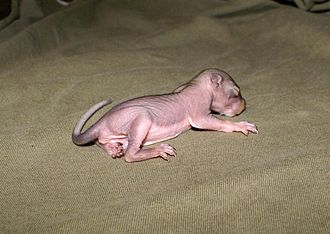
Eastern gray squirrels can breed twice a year, but younger and less experienced mothers normally have a single litter per year in the spring. Depending on forage availability, older and more experienced females may breed again in summer. [29] In a year of abundant food, 36% of females bear two litters, but none will do so in a year of poor food. [16] Their breeding seasons are December to February and May to June, though this is slightly delayed in more northern latitudes. [19] [27] The first litter is born in February or March, the second in June or July, though, again, bearing may be advanced or delayed by a few weeks depending on climate, temperature, and forage availability. In any given breeding season, an average of 61 – 66% of females bear young. [16] If a female fails to conceive or loses her young to unusually cold weather or predation, she re-enters estrus and has a later litter. Five days before a female enters estrus, she may attract up to 34 males from up to 500 meters away. Eastern gray squirrels exhibit a form of polygyny, in which the competing males will form a hierarchy of dominance, and the female will mate with multiple males depending on the hierarchy established. [16]
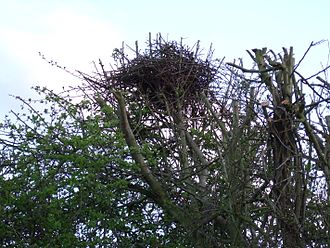
Normally, one to four young are born in each litter, but the largest possible litter size is eight. [16] The gestation period is about 44 days. [16] The young are weaned around 10 weeks, though some may wean up to six weeks later in the wild. They begin to leave the nest after 12 weeks, with autumn born young often wintering with their mother. Only one in four squirrel kits survives to one year of age, with mortality around 55% for the following year. Mortality rates then decrease to around 30% for following years until they increase sharply at eight years of age. [16]
Rarely, eastern gray females can enter estrus as early as five and a half months old, [27] but females are not normally fertile until at least one year of age. Their mean age of first estrus is 1.25 years. [16] The presence of a fertile male will induce ovulation in a female going through estrus. [16] Male eastern grays are sexually mature between one and two years of age. [30] Reproductive longevity for females appears to be over 8 years, with 12.5 years documented in North Carolina. [16] These squirrels can live to be 20 years old in captivity, but in the wild live much shorter lives due to predation and the challenges of their habitat. At birth, their life expectancy is 1–2 years, an adult typically can live to be six, with exceptional individuals making it to 12 years.
Growth and ontogeny
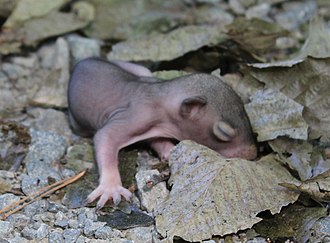
Newborn gray squirrels weigh 13–18 grams and are entirely hairless and pink, although vibrissae are present at birth. 7–10 days postpartum, the skin begins to darken, just before the juvenile pelage grows in. Lower incisors erupt 19–21 days postpartum, while upper incisors erupt after 4 weeks. Cheek teeth erupt during week 6. Eyes open after 21–42 days, and ears open 3–4 weeks postpartum. Weaning is initiated around 7 weeks postpartum, and is usually finished by week 10, followed by the loss of the juvenile pelage. Full adult body mass is achieved by 8–9 months after birth. [16]
Communication
As in most other mammals, communication among eastern gray squirrel individuals involves both vocalizations and posturing. The species has a quite varied repertoire of vocalizations, including a squeak similar to that of a mouse, a low-pitched noise, a chatter, and a raspy “mehr mehr mehr”. Other methods of communication include tail-flicking and other gestures, including facial expressions. Tail flicking and the “kuk” or “quaa” call are used to ward off and warn other squirrels about predators, as well as to announce when a predator is leaving the area. [31] Squirrels also make an affectionate coo-purring sound that biologists call the “muk-muk” sound. This is used as a contact sound between a mother and her kits and in adulthood, by the male when he courts the female during mating season. [31]
The use of vocal and visual communication has been shown to vary by location, based on elements such as noise pollution and the amount of open space. For instance, populations living in large cities generally rely more on the visual signals, due to the generally louder environment with more areas without much visual restriction. However, in heavily wooded areas, vocal signals are used more often due to the relatively lower noise levels and a dense canopy restricting visual range. [32]
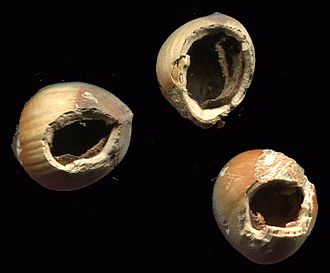
Hazelnuts gnawed by gray squirrel; the curved cut marks left by the sharp incisors are visible around the holes
Eastern gray squirrels eat a range of foods, such as tree bark, tree buds, flowers, [33] berries, many types of seeds and acorns, walnuts, and other nuts, like hazelnuts (see picture) and some types of fungi found in the forests, including fly agaric mushrooms (Amanita muscaria). [34] They can cause damage to trees by tearing the bark and eating the soft cambial tissue underneath. In Europe, sycamore (Acer pseudoplatanus L.) and beech (Fagus sylvatica L.) suffer the greatest damage. [35] The seeds and catkins of gymnosperms cedar, hemlock, pine, and spruce are another food source, [33] as well as those of angiosperms such as hickory, oak, and walnut, and truffles. [36] The squirrels also raid gardens for wheat, [33] tomatoes, corn, strawberries, and other garden crops. [37] Sometimes they eat the tomato seeds and discard the rest. On occasion, eastern gray squirrels also prey upon insects, frogs, small rodents including other squirrels, and small birds, their eggs, and young. [2] [27] They also gnaw on bones, antlers, and turtle shells – likely as a source of minerals scarce in their normal diet. [34]
Eastern gray squirrels have a high enough tolerance for humans to inhabit residential neighborhoods and raid bird feeders for millet, corn, and sunflower seeds. Some people who feed and watch birds for entertainment also intentionally feed seeds and nuts to the squirrels for the same reason. [38] However, in the UK eastern gray squirrels can take a significant proportion of supplementary food from feeders, preventing access and reducing use by wild birds. [39] Attraction to supplementary feeders can increase local bird nest predation, as eastern gray squirrels are more likely to forage near feeders, resulting in increased likelihood of finding nests, eggs and nestlings of small passerines. [40]
Predation
Predators include hawks, weasels, raccoons, bobcats, foxes, domestic and feral cats, snakes, owls, and dogs. [27] In its introduced range in South Africa, it has been preyed on by African harrier-hawks. [41]
Habitat
In the wild, eastern gray squirrels can be found inhabiting large areas of mature, dense woodland ecosystems, generally covering 100 acres (40 hectares) of land. [27] These forests usually contain large mast-producing trees such as oaks and hickories, providing ample food sources. Oak-hickory hardwood forests are generally preferred over coniferous forests due to the greater abundance of mast forage. [19] This is why they are found only in parts of eastern Canada which do not contain boreal forest (i.e. they are found in some parts of New Brunswick, in southwestern Quebec, throughout southern Ontario and in southern Manitoba).
Eastern gray squirrels generally prefer constructing their dens upon large tree branches and within the hollow trunks of trees. They also have been known to take shelter within abandoned bird nests. The dens are usually lined with moss plants, thistledown, dried grass, and feathers. These perhaps provide and assist in the insulation of the den, used to reduce heat loss. A cover to the den is usually built afterwards. [ citation needed ]
Close to human settlements, eastern gray squirrels are found in parks and back yards of houses within urban environments and in the farmlands of rural environments. [42]
Introductions
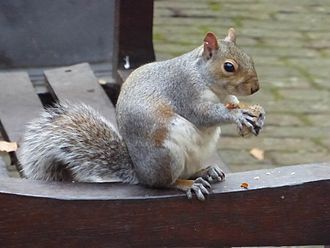
The eastern gray squirrel is an introduced species in a variety of locations in western North America: in western Canada, to the southwest corner of British Columbia and to the city of Calgary, Alberta; [13] in the United States, to the states of Washington and Oregon and, in California, to the city of San Francisco and the San Francisco Peninsula area in San Mateo and Santa Clara Counties, south of the city. It has become the most common squirrel in many urban and suburban habitats in western North America, from north of central California to southwest British Columbia.
By the turn of the 20th century, breeding populations of the eastern gray squirrel had been introduced into South Africa, Ireland, Italy, Australia (extirpated by 1973), and the United Kingdom. [43]
In South Africa, though exotic, it is not usually considered an invasive species owing to its small range (only found in the extreme southwestern part of the Western Cape, going north as far as the small farming town of Franschhoek), as well because it inhabits urban areas and places greatly affected by humans, such as agricultural areas and exotic pine plantations. Here, it mostly eats acorns and pine seeds, although it will take indigenous and commercial fruit, as well. [44] Even so, it is unable to use the natural vegetation (fynbos) found in the area, a factor which has helped to limit its spread. [45] It does not come into contact with native squirrels due to geographic isolation (a native tree squirrel, Paraxerus cepapi, is found only in the savanna regions in the northeast of the country) [46] and different habitats.
Gray squirrels were first introduced to Britain in the 1870s, as fashionable additions to estates. [47] In 1921 it was reported in The Times that the Zoological Society of London had released Eastern Greys to breed at liberty in Regents Park:
A dozen years ago the Zoological Society of London obtained a number from a private collection in Bedfordshire for the purpose of inducing them to breed at liberty in the Gardens in Regent’s Park. They were first kept in a large enclosure from which, when they had become used to visitors, they were allowed to pass in and out by a rope bridge to a tree. It was hoped that they would spread from the Gardens to the Park. After two or three years in which they seemed to be disappearing, they suddenly became ubiquitous. The grey squirrels are plainly happy and plainly give happiness to Londoners. On the other hand, grey squirrels, whether by taking advantage of tubes and buses, or by deliberate human connivance, have spread from London and are invading the country over very wide areas. They are said to drive out the red squirrel, to raid gardens, and to add to the anxieties of the pheasant breeder. We hope that fuller inquiry will not sustain these charges. [48]
They spread rapidly across England, and then became established in both Wales and parts of southern Scotland. On mainland Britain, they have almost entirely displaced native red squirrels. Larger than red squirrels and capable of storing up to four times more fat, gray squirrels are better able to survive winter conditions. They produce more young and can live at higher densities. Gray squirrels also carry the squirrelpox virus, to which red squirrels have no immunity. When an infected gray squirrel introduces squirrelpox to a red squirrel population, its decline is 17–25 times greater than through competition alone. [47]
In Ireland, the displacement of red squirrels has not been as rapid because only a single introduction occurred, in County Longford. Schemes have been introduced to control the population of gray squirrels in Ireland to encourage the native red squirrels. Eastern gray squirrels have also been introduced to Italy, and the European Union has expressed concern that they will similarly displace the red squirrel from parts of the European continent.
Displacement of red squirrels
In Britain and Ireland, the eastern gray squirrel is not regulated by natural predators, [49] other than the European pine marten, which is generally absent from England and Wales. [50] This has aided its rapid population growth and has led to the species being classed as a pest. Measures are being devised to reduce its numbers, including a campaign starting in 2006 named “Save Our Squirrels” using the slogan “Save a red, eat a grey!” which attempted to re-introduce squirrel meat in to the local market, with celebrity chefs promoting the idea, [51] cookbooks introducing recipes containing squirrel and the Forestry Commission providing a regular supply of squirrel meat to British restaurants, factories and butchers. [52] In areas where relict populations of red squirrels survive, such as the islands of Anglesey, Brownsea and the Isle of Wight, programs exist to eradicate gray squirrels and prevent them from reaching these areas in order to allow red squirrel populations to recover and grow. [53]
Although complex and controversial, the main factor in the eastern gray squirrel’s displacement of the red squirrel is thought to be its greater fitness, hence a competitive advantage over the red squirrel on all measures. [54] The eastern gray squirrel tends to be larger and stronger than the red squirrel and has been shown to have a greater ability to store fat for winter. The squirrel can, therefore, compete more effectively for a larger share of the available food, resulting in relatively lower survival and breeding rates among the red squirrel. Parapoxvirus may also be a strongly contributing factor; red squirrels have long been fatally affected by the disease, while the eastern gray squirrels are unaffected, but thought to be carriers – although how the virus is transmitted has yet to be determined. However, several cases of red squirrels surviving have been reported, as they have developed an immunity – although their population is still being massively affected. The red squirrel is also less tolerant of habitat destruction and fragmentation, which has led to its population decline, while the more adaptable eastern gray squirrel has taken advantage and expanded.
Similar factors appear to have been at play in the Pacific region of North America, where the native American red squirrel has been largely displaced by the eastern gray squirrel in parks and forests throughout much of the region.
Ironically, “fears” for the future of the eastern gray squirrel arose in 2008, as the melanistic form (black) began to spread through the southern British population. [55] In the UK, if a “grey squirrel” (eastern gray squirrel) is trapped, under the Wildlife and Countryside Act 1981, it is illegal to release it or to allow it to escape into the wild; instead, it is legally required be “humanely dispatched”. [56]
In the late 1990s, Italy’s National Wildlife Institute and University of Turin launched an eradication attempt to halt the spread of gray squirrels in northwest Italy, but court action by animal rights groups blocked this. Hence gray squirrels are expected to cross the Alps into France and Switzerland in the next few decades. [57] [58]
Fossil record of the eastern gray squirrel
Twenty different Pleistocene fauna specimens contain S. carolinensis, found in Florida and dated to be as early as the late Irvingtonian period. [16] Body size seems to have increased during the early to middle Holocene and then decreased to the present size seen today.
Bobcat Diet: What Do Bobcats Eat?
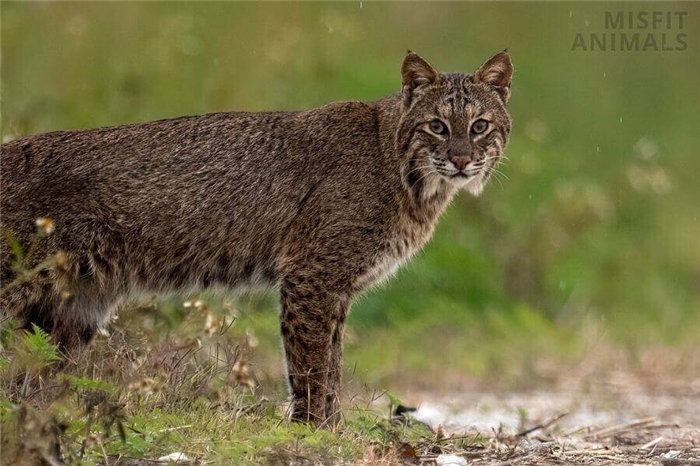
Misfit Animals is reader-supported. When you buy via links on our site, we may earn an affiliate commission at no cost to you. Learn More.
Bobcats are predatory carnivores and mainly eat small prey animals. They eat almost anything they can catch. They are very efficient hunters and choose to hunt what is mostly available in their habitat.
Bobcats mostly eat medium-sized animals, rarely attempting to hunt anything bigger than themselves. Although they do possess the ability to do so.
As they are felines, they feed on the same things as other cats: meat.
But how do they catch their prey, and what animals do they prey on?
In this article, we’ll offer you the answers to these questions and more about the Bobcat.
What Do Bobcats Eat?
Bobcats eat meat, no matter the species it originates from. They are carnivores, relying primarily on animal protein for nutrition. Bobcats don’t refuse a juicy piece of meat, as long as they can catch the animal.
Depending on what’s available to them they will eat a wide variety of animals:
- Insects
- Small birds, reptiles, and rodents
- Medium-sized mammals, reptiles, and birds
- Big mammals
- Smaller livestock (such as pigs, sheep, goats, and poultry)
- Even pets (like smaller dogs and cats)
1. Insects
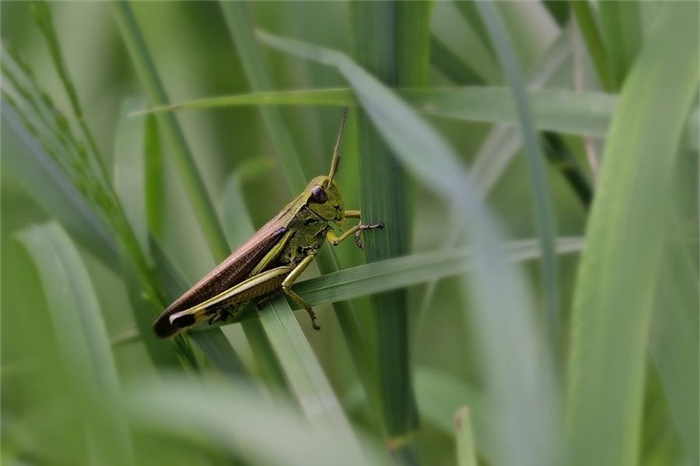
Bobcats are in no way insectivores, but they do eat insects on occasion. They use their keen senses to catch insects such as grasshoppers.
While a few bugs are not enough to sustain a Bobcat, they provide a bit of easy nutrition.
2. Small Animals
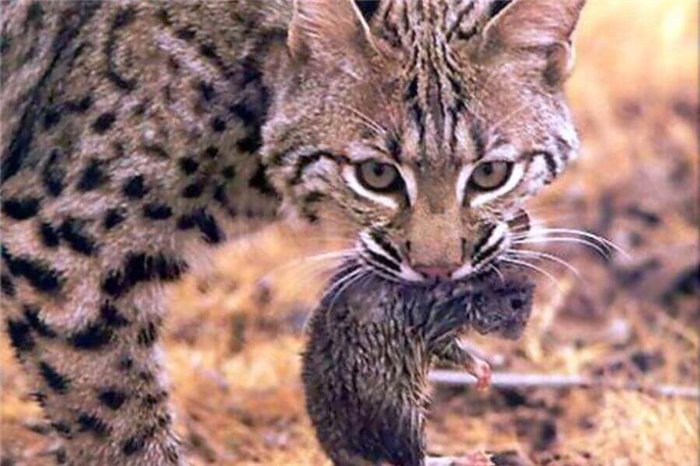
Image Source
Bobcats are great at taking advantage of the environment around them. They don’t shy away from catching smaller animals including lizards, snakes, and small birds. They can even catch birds mid-flight.
In some regions, bobcats’ main sources of food are small mammals, especially rodents such as squirrels, mice, and rats.
The bobcat is efficient enough to catch such prey regularly, so they rarely find themselves lacking food.
3. Medium-Sized Animals
Bobcats frequently hunt and eat hares, rabbits, or similar-sized animals. They make for filling meals, as they are good sources of protein. [1]
Because bobcats are such efficient hunters, hare-sized animals are always open season for bobcats. They even catch reptiles and birds that scare humans away, such as snakes.
4. Big Mammals
While it’s not their preferred prey, bobcats do hunt bigger animals such as deer, pronghorn, and elk. Hunting these larger animals comes with a risk, which is why bobcats normally refrain from hunting them.
When they do hunt large mammals, they tend to target fawns, juveniles, or weak individuals, as these are easier to kill than adults.
5. Small Livestock
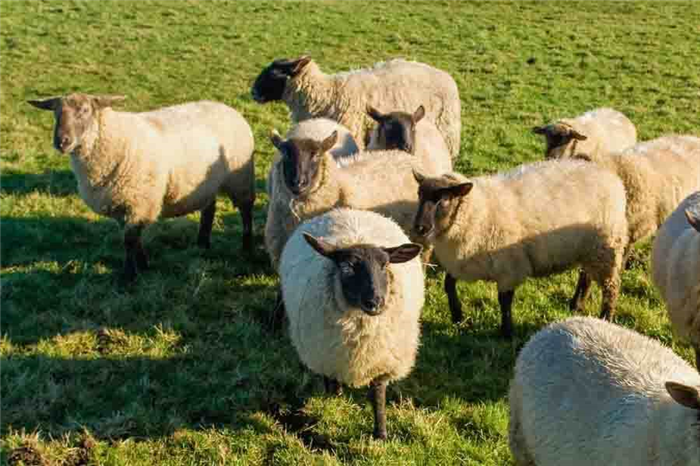
While not the greatest menace to domestic animals, bobcats do pose a threat to smaller-sized livestock and poultry. This includes sheep, goats, and pigs.
Bobcats are also more than capable of making domestic birds disappear from yards and farms, including ducks, chickens, and geese.
6. Pets
Bobcats do attack pets on occasion. While big dogs and maybe other larger-sized pets are safe, your average small dogs and cats are most certainly in danger.
Even if you have a larger dog, do not walk it without a leash, especially around trails. It might run off and have an encounter with a bobcat or other wild animals.
While bobcats usually don’t attack large dogs with the intent to hunt them, they are capable of doing a lot of damage, especially if they feel threatened.
Are Bobcats Carnivores or Omnivores?
Bobcats are carnivores. Carnivores are animals that primarily or solely eat meat, while omnivores eat both meat and plants to survive. While bobcats do eat the occasional berry, the majority of their diet is meat.
Bobcats are, like all other felines, carnivores, meaning they eat meat to survive. However, they still occasionally consume plant materials.
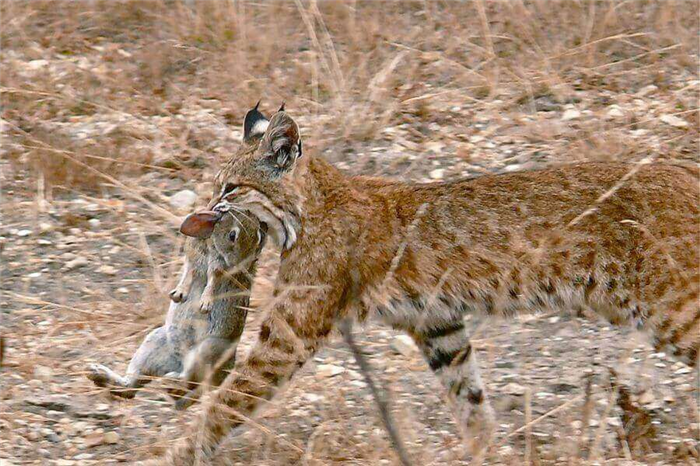
Image Source
The Bobcat’s Diet
Bobcats’ diet of meat varies a lot, depending on the region they live in and the prey available to them in said region. This includes rabbits, hares, squirrels, and other small animals.
What Do Bobcats Like to Eat?
Bobcats’ preferred prey across all regions according to many studies seems to be rabbits and hares. [2]
Bobcats tend to hunt and feed on the regional species of hares or rabbits available. In the northern United States, studies show that Bobcats prefer snowshoe hare to other types of prey. In the Potosino-Zacatecano Plateau of Mexico, they prefer eastern cottontail rabbits.
Regardless of its preferred prey, this North American feline is not a choosy beggar, eating a wide variety of food.
Bobcat populations towards the south get a larger amount of their nutrition from smaller animals compared to the average northern bobcat’s diet. This is because of the abundance of such prey.
Because they hunt smaller animals, they find themselves in competition with foxes, hawks, and falcons.
Bobcats vs. Lynxes
When comparing bobcats and lynxes, they appear much more versatile in their diet.
Because of this versatility, they do not need to specialize in one kind of prey.
To put this into perspective, the Canada lynx which shares territories with the bobcat will hunt snow hares regardless of its availability.
Meanwhile, in ranges that the Bobcat shares with the lynx, the former switches to hunting more squirrels and other smaller rodents if these are more available.
A Montana-based study shows that western groups of bobcats ate much more small rodent meat compared to their eastern counterparts. While they share territory with the lynx, bobcats feed more on squirrels and rats, even if hares are abundant. [3]
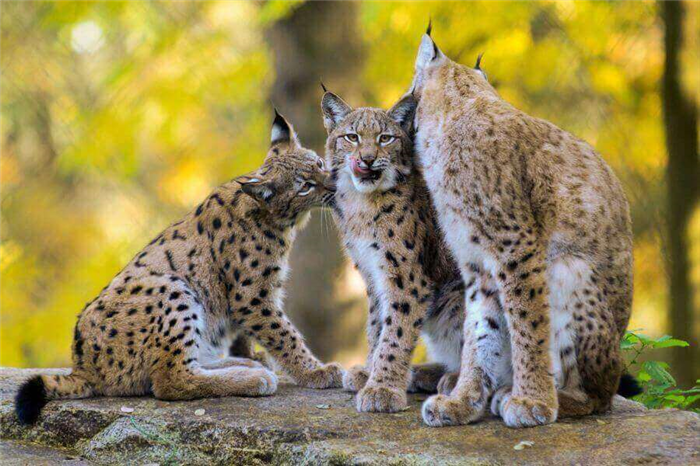
What Do Baby Bobcats Eat?
Baby bobcats drink their mother’s milk, like any other felines. They do so until they are able to start eating meat, which happens around the age of two months.
Baby Bobcats are called kittens. At the beginning of their life, they feed on their mother’s milk. They are completely dependent on their mother, as they can’t see or do much by themselves. [4]
The kittens are weaned after about two months. At this stage, they start eating meat that their mother catches and brings to them.
Between the age of three and five months, they start traveling with their mother. If they were born in April or May (as is most common) they start hunting by themselves in the fall of the same year.
How Often Do Bobcats Eat?
Bobcats eat as often as they can. They take advantage of any opportunity to eat and store their food if they don’t eat all of their prey in one sitting.
Bobcats are inherently opportunistic predators.
Similar to the other three species in the Lynx genus, they prefer to eat regularly. They catch smaller prey daily, such as hares, or hunt for larger prey every other day.
They aren’t always successful on their hunts though, either because of the time of the year or a lack of suitable prey.
When the prey animals that they prefer to hunt are scarce, bobcats usually hunt bigger animals, such as deer, pronghorn, or the rare elk.
When and if a Bobcat manages to catch and kill larger prey, it eats as much as it needs at the time and stashes the carcass for later consumption. Bobcats hide the rest of their meals by burying them in snow or beneath the leaves.
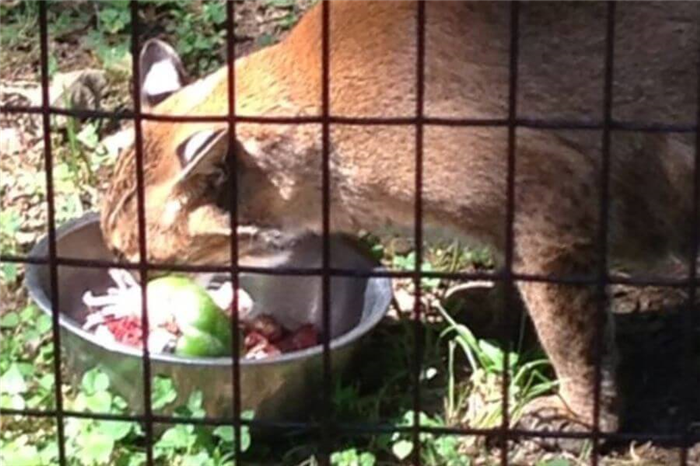
Image Source
Do Bobcats Eat Humans?
Bobcats do not actively hunt humans. They can hurt humans if they want to, but they are elusive, shy, and solitary animals so they prefer to stay out of our way.
While not a giant animal by any means, the Bobcat is not to be taken lightly. It can be very dangerous to humans, though they never attack.
They are medium-sized felines, on average about twice as large as a housecat.
| Species | Avg. Length | Avg. Weight |
| Average Housecat | 18 inches | 9 to 12 pounds |
| Bobcat | 28 to 47 inches | 15 to 35 pounds |
| Cougar | 6 to 9 feet | 135 to 200 pounds |
Comparing their size to the housecats and knowing the damage our furry friends can do with their small claws, you can imagine the damage that being slashed by a bobcat’s one-inch claws will do.
How to Avoid Attracting Bobcats
Don’t give bobcats a chance at a free meal. By leaving food outside you encourage wildlife to try and take it. Taking food from yards is easier for a Bobcat than hunting. They get used to this and learn that where there are humans there is also an easy meal.
Bobcats are opportunists. Like most opportunistic animals they will seize any chance of an easy meal by taking it from humans and our pets.
It’s a good idea to avoid leaving pet food outside, but human food waste, even plant material such as fruit and seeds still attracts some unwanted attention. [5]
While they are carnivores, bobcats will not deny themselves the pleasures of a salad or some fruit. This especially applies to those living around urban habitats.
Bobcats pick the easy meal every time so don’t teach them that your yard is an all-you-can-eat buffet.
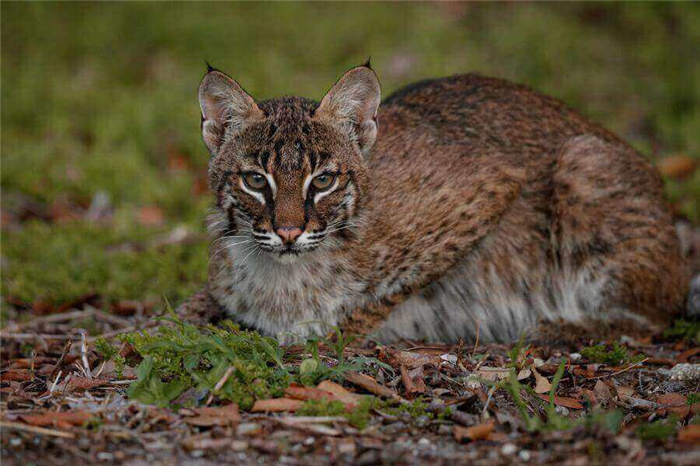
How Do Bobcats Hunt?
Bobcats are ambush hunters. They will try to surprise their prey and catch it from the first pounce. Even if this doesn’t work they still chase it a bit to get the kill. Bobcats do adapt their hunting style depending on their target.
Bobcats are versatile in their style of hunting, adjusting it depending on what and when they hunt.
For medium and small-sized animals, bobcats ambush them by laying in wait until the prey is in range (20 to 35 feet). When the time comes, they pounce on the unaware animal.
If they don’t succeed the first time, they will chase it a small distance. In the case of birds, bobcats leap into the air to catch them.
When they hunt larger prey, such as deer, bobcats get in close while the deer is laying down. They try to grab it by the neck like a lion would an antelope.
Conclusion
So, what do bobcats eat? Like any other carnivore, bobcats eat meat.
While they occasionally eat a berry or two and need milk when they are kittens, bobcats need animal protein to survive.
They are not only great hunters, but versatile ones. They can survive and thrive in many different regions throughout North America, from Canada to southern Mexico and all the way in between.
Do Bobcats Have Predators?
Yes, although not too many, there are several animals that occasionally kill bobcats, such as mountain lions, wolves, and even alligators. Bears can also easily kill them. They can also suffer attacks from coyotes and fishers, but this is more of mutual predation.
Do Bobcats Eat Owls?
Not healthy adult owls, they are risky birds to try and prey on. They can sneak up on unguarded nests and use their climbing abilities to get to baby owls and eggs. They also take advantage of an injured owl as ones that can’t fly are easy targets.
Do Bobcats Eat Cats?
Yes, they do. Bobcats are larger, stronger, and faster than even the biggest cat like a Maine Coon. They often catch stray cats and outside cats from backyards. Avoid leaving your pets outside, as even a small bobcat is a danger to them.
Do Bobcats Eat Plants?
Yes, like most felines bobcats also eat some plant materials every now and then. They will instinctually consume some grass and fruits such as berries. They also eat plants indirectly by consuming the stomach content of their prey.
What Do Bobcats Eat?
Beautiful, elusive bobcats have a massive range that extends throughout the United States, Canada, and central Mexico. This nocturnal hunter is a successful predator, but what are a bobcat’s favorite meals? Read on to learn about what bobcats eat.
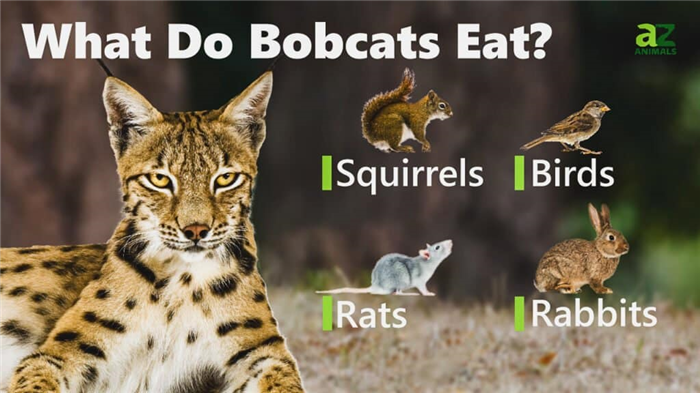
Bobcats eat squirrels, birds, rats, and rabbits.
A bobcat (Lynx rufus) is a small member of the Lynx family. It is the most common wild cat in North America. It resembles its cousin the Canada lynx. It has the same pointed, furred ears, but it is much smaller. The average bobcat weighs from 13 to 40 pounds, and males are larger than females.
You can find these wild cats in almost every state of the United States, but it’s hard to spot them because these predators are excellent at hiding from human view. They have adapted to survive in arid deserts, temperate forests, subtropical forests, and snowy mountain regions. These hardy, adaptable cats vary their diet according to what is available in their environment.
What Does a Bobcat Eat?
As an obligate carnivore and a skilled hunter, it eats smaller mammals and birds. It prefers rabbits and hares, but it will hunt and eat larger animals if its preferred food isn’t available. As a result, its diet depends largely on what is around and is easy for a bobcat to hunt.
In the New England states, snowshoe hares are their primary food source. A study published in the Journal of Wildlife Management found that bobcats in Maine primarily hunted snowshoe hares (Lepus americanus). This study found that up to 76% of the cats in the region ate these hares, which were abundant in the region.
The researchers also found that these animals preferred to hunt in so-called dense understories, which are forested areas that have high numbers of hardwood trees.
Bobcat Diet in Snowy Regions
Another study examined the effects of deep winter snows and food scarcity on bobcat diets.
This study found that wild cats in snowy regions mostly eat the following animals:
-
: These made up more than half the bobcats’ diet. and cotton rats: 25%
- Snowshoe hares: 12% : 8% : less than 8%
Cotton rats (Sigmodon hispidus) are large rodents that live in most of the western and central United States.
Mountain Ranges
In the Pacific Northwest, bobcats have shown how well they adapt to different environments. In 1988, researchers studied the hunting and eating habits of bobcats in Oregon’s Cascade Mountains.
These were the primary foods they ate.
- Snowshoe hares: 30% of bobcats ate them.
- Black-tailed deer (Odocoileus hemionus): 22% ate them.
- Mountain beaver (Aplodontia rufa): 12% ate beavers. and moles: The range of bobcats eating them went from 9% in winter to 37% in spring. : These were eaten by 10% and were mostly grouse.
The researchers found that the bobcats’ diet changed in the spring and summer. During warmer months, for instance, they were more likely to eat beavers and rodents. Of these rodents, squirrels were the animals they ate most often.
“The variety of prey identified in the bobcat diet increased from 17 during the winter to 35 during the spring,” they observed. “The second greatest change in bobcat diets between successive seasons occurred between summer and fall.” During the change to fall weather, the wild cats ate more hare, deer, and rodents, and they decreased their hunting of beavers, mice, and birds.
Desert Diet
Bobcats also live in desert climates. What do they eat there?
A study of their hunting habits in desert regions followed bobcats living in the Chihuahua Desert of Mexico. This is a dry, rocky region where bobcats are the only wild cat and largest predator. In this area, they showed a strong preference for rabbits over other available prey. These bobcats also ate rock squirrels, mice, raccoons, and lizards.
Although farmers in the area were fearful that bobcats would eat their sheep and goats, there was no evidence that bobcats had eaten any livestock. These wild cats have shown they can survive in almost any environment that has a good supply of small mammals and birds.
A Complete List of Top 10 Foods Bobcats Eat
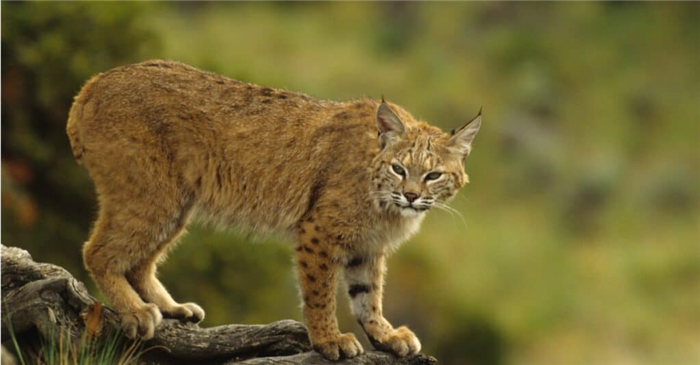
Bobcats are most active at dawn and dusk.
Like most felines, they are most active at dawn and dusk. When the light is low, they come out of their dens to stalk their prey. They usually wake up before sunset, hunt, and then go to sleep. Before dawn, they are up and hunting again.
Bobcats use ambush techniques to catch their prey. They have sharp hearing and sight, even in low light. They repeatedly cross through their chosen territory listening and watching for small animals. When it hears or sees something, the bobcat will freeze into position and wait for the animal to appear from the grass or shrubs. The bobcat pounces on the animal, pins it with a paw, and bites the prey’s neck.
Are They Good Hunters?
Bobcats are excellent hunters. They can even hunt and kill animals much larger than they are. When they kill deer, they leap onto the deer’s back from a tree and bite its throat. Bobcats mostly hunt fawns, but they have been known to kill adults when their preferred prey is scarce.
They prefer to hunt smaller game, however, and their favorites are rabbits and hares.
Share this post on:
AZ Animals Staff
AZ Animals is a growing team of animals experts, researchers, farmers, conservationists, writers, editors, and — of course — pet owners who have come together to help you better understand the animal kingdom and how we interact.
FAQs (Frequently Asked Questions)
Is the bobcat an herbivore, carnivore or omnivore?
It is a carnivore. It eats rabbits, mice, squirrels, and other small mammals.
Do they have any predators?
An adult bobcat has few predators, but owls, foxes, and coyotes often hunt bobcat babies. However, bobcats are popular targets of hunting for the fur trade. Bobcat hunting is legal in several states and Canada, and trophy hunting of bobcats is legal in Mexico. All these countries strictly regulate the hunts, and bobcats are a protected species in about 10 states.
Are bobcats endangered?
They are not endangered. They are listed as a species of “least concern” for conservation status. Habitat destruction and other environmental factors, however, have damaged bobcat populations in some areas.
In the Florida Everglades, for instance, introduced Burmese pythons have become a major problem. These invasive snakes can grow large enough to eat deer, alligators, and at least one bobcat.
Even more concerning, these snakes regularly eat the small mammals and rodents that bobcats depend on for survival. Their presence has harmed populations of endangered animals and decimated the populations of deer, bobcats, raccoons, rabbits, and shorebirds. They have wiped out opossums and foxes.
To control these invasive snakes, Florida’s government has hired teams of professional snake hunters. The state holds a yearly Python Challenge that awards cash prizes to the hunters who catch the most pythons.
Do bobcats live in every U.S. state?
They have colonies in every state except Delaware. They may pass through the state on their hunting trips, but they don’t live there.
What do bobcats eat?
A donation of any size will help sustain our educational efforts. Simply select- Education, Conservation, Science, Research for your designation.
The bobcat (Lynx rufus) can be identified most easily by its short bob-tail which is 2 to 8 inches long. The tail has black fur on the top and is white on the underside. It has a wide flat face with longer fur on the cheek area. It has long legs and big paws. Its color ranges from an orange-ish brown to pale gray with black spots and bars on it legs and chest and less noticeable spots throughout its body.
Adaptations
The bobcats ability to adapt to many different habitats and ranges is what has made it such a successful species. In the Sonoran Desert is has adapted to survive on marginal habitats. A marginal habitat is one that might not be as rich in prey or shelter as other places.
Habitat
The bobcat can be found throughout the Sonoran Desert. It prefers rocky areas with plenty of plant cover, but can be found in mountain forests, riparian canyons, brushland, and in populated suburban areas.
Range
The range of the bobcat is quite large. They can be found from southern Canada, throughout the United States and into northern and central Mexico
Wild Status
Overall, the population of the bobcat is fairly stable. In some areas their numbers are increasing and in other areas the population is declining. They are currently listed as a species of least concern.
Diet
Bobcats are carnivores and thus prefer an all meat diet. Their food of choice is rabbits, but they will also eat birds, lizards, rodents, snakes, and carrion. On occasion they have been known to kill deer.
Predators
Predators of the bobcat include mountain lions, coyotes, foxes, owls, wolves, and humans.
Home
Bobcats will usually change their shelter on a daily basis. When they are not active they will rest in hollow logs, a rocky den, a cave, a low tree branch, a boulder or some other covered shelter. When the female has kittens to care for she will have several dens and will move the kittens round between them.
Life Span
Bobcats can live to be 13-15 years old in the wild.
Size
Bobcats generally weigh between 15 and 30 pounds. Males are larger than the females. Their body length is 20 to 50 inches.
Quick Facts
- Bobcats are found only in North America.
- Bobcats often ambush their prey by waiting motionless and then pouncing on it. This is the same hunting technique used by the mountain lion.
©Copyright 2008, Arizona-Sonora Desert Museum
